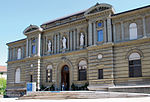Bern railway station (German: Bahnhof Bern) serves the municipality of Bern, the federal city of Switzerland. Opened progressively between 1858 and 1860, and rebuilt several times since then, it lies on the Olten–Bern and the Lausanne–Bern lines (together forming the line known as the Mittellandlinie in German) and is near the end of the Lötschberg line. The station is owned by the Swiss Federal Railways (SBB CFF FFS). Train services to and from the station are operated by the Swiss Federal Railways, the Bern-Lötschberg-Simplon railway (BLS) and the metre gauge Regionalverkehr Bern-Solothurn (RBS). Trains calling at the station include ICEs, and international trains to Italy.
Bern is the nearest station to the University of Bern in the Länggasse quarter. There is a rooftop terrace on top of the station, accessed by lift from the subway by Platforms 12 and 13, with views over the city and to the Bernese Alps. Access to Bern Airport from the station is normally via rail to Belp station and then by connecting bus, but the first and last buses each day run directly between Bern station and the airport. It has an IATA Airport Code (ZDJ), as American Airlines codeshares on the Swiss Federal Railways service from Zurich Airport in Zürich.Between 1999 and 2003, the station was renovated and partially redesigned. Presently, the site contains Rail City, a shopping center open for longer opening hours than most other shops in the city, and also on Sundays and public holidays, when most other shops would be close; this is possible as the shop opening laws of the Canton and the city of Bern do not apply to federally-owned real estate. The station has six standard-gauge platforms serving twelve tracks (numbered 1–10 and 12–13) and two meter gauge RBS platforms serving four tracks (numbered 21–24). Curiously, there is no platform 11, but there is a through railway track with no platform face between platforms 10 and 12. The station interchanges with many local bus, tram and trolley bus routes (operated by BERNMOBIL) and regional bus services (operated by PostAuto).
Amid projections of dramatically increasing passenger numbers, plans for a major expansion and development of Bern Station, largely focusing upon new underground areas, were mooted during the 2010s. Swiss Federal Railways, Regional Bern-Solothurn, and the city of Bern are the key backers behind this development. On 26 June 2017, authorisation to proceed with the planned station expansion was issued and construction activity commenced during the following month. The renovated station was expected to be completed by the end of 2025, but was delayed until 2027, and has now been delayed until 2029










